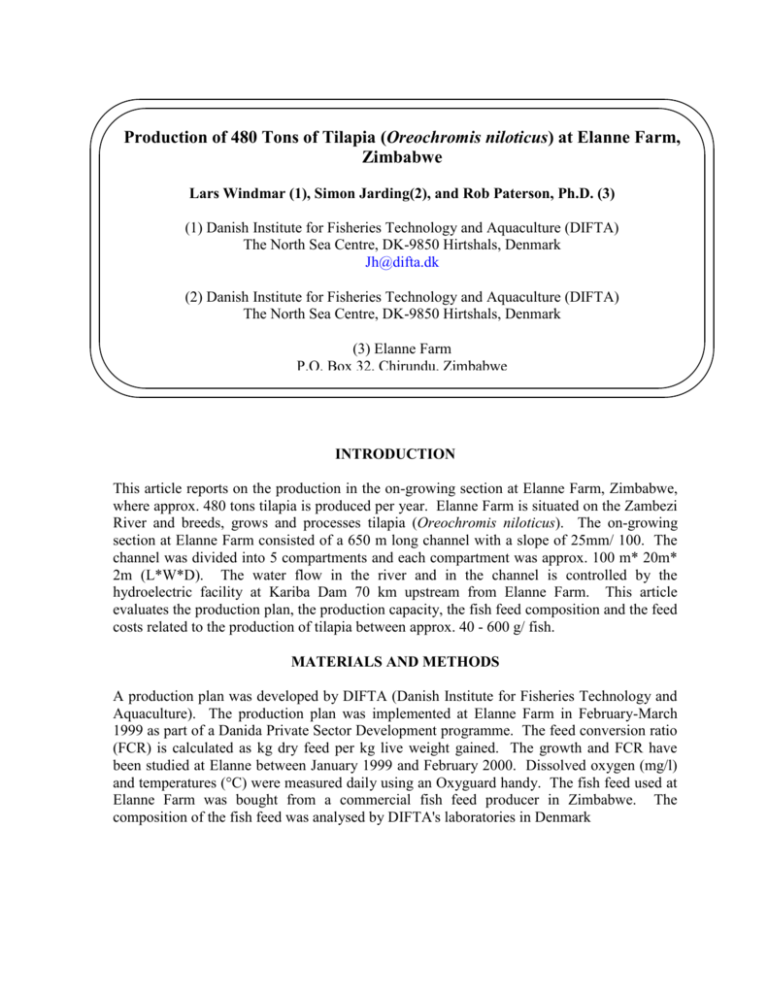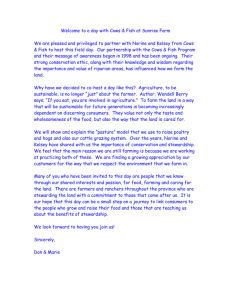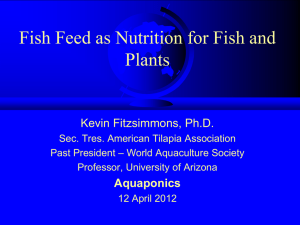Production Capacity
advertisement

Production of 480 Tons of Tilapia (Oreochromis niloticus) at Elanne Farm, Zimbabwe Lars Windmar (1), Simon Jarding(2), and Rob Paterson, Ph.D. (3) (1) Danish Institute for Fisheries Technology and Aquaculture (DIFTA) The North Sea Centre, DK-9850 Hirtshals, Denmark Jh@difta.dk (2) Danish Institute for Fisheries Technology and Aquaculture (DIFTA) The North Sea Centre, DK-9850 Hirtshals, Denmark (3) Elanne Farm P.O. Box 32, Chirundu, Zimbabwe INTRODUCTION This article reports on the production in the on-growing section at Elanne Farm, Zimbabwe, where approx. 480 tons tilapia is produced per year. Elanne Farm is situated on the Zambezi River and breeds, grows and processes tilapia (Oreochromis niloticus). The on-growing section at Elanne Farm consisted of a 650 m long channel with a slope of 25mm/ 100. The channel was divided into 5 compartments and each compartment was approx. 100 m* 20m* 2m (L*W*D). The water flow in the river and in the channel is controlled by the hydroelectric facility at Kariba Dam 70 km upstream from Elanne Farm. This article evaluates the production plan, the production capacity, the fish feed composition and the feed costs related to the production of tilapia between approx. 40 - 600 g/ fish. MATERIALS AND METHODS A production plan was developed by DIFTA (Danish Institute for Fisheries Technology and Aquaculture). The production plan was implemented at Elanne Farm in February-March 1999 as part of a Danida Private Sector Development programme. The feed conversion ratio (FCR) is calculated as kg dry feed per kg live weight gained. The growth and FCR have been studied at Elanne between January 1999 and February 2000. Dissolved oxygen (mg/l) and temperatures (°C) were measured daily using an Oxyguard handy. The fish feed used at Elanne Farm was bought from a commercial fish feed producer in Zimbabwe. The composition of the fish feed was analysed by DIFTA's laboratories in Denmark RESULTS Production Plan Production of 480 tons of whole fish per year at Elanne fish farm. From stocking size fingerlings of 40 g/ fish to market size of 600 g/fish, approx. 15 % of the total number of fish are lost due to predation. Table 1: 480 Tons Production: Fish Size, Number of Fish, Feed Conversion Ratio (FCR), Biomass, Biomass Increase and Feed Consumption. Months 4 5 7 9 11 14 Size (g) 40 100 220 340 460 600 No of fish 920,000 890,000 860,000 840,000 820,000 800,000 FCR 1.2 1.4 1.6 1.8 2 2 Biomass (kg) 36,800 89,000 189,200 285,600 377,200 480,000 Total Biomass increase (kg) 10,800 52,200 100,200 96,400 91,600 102,800 443,200 kg Feed consumption 12,960 73,080 160,320 173,520 183,200 205,600 808,680 kg At Elanne farm fingerlings with a size of approx. 40 g can be produced in 4 months. The ongrowing period, where the tilapia grow from fingerlings to the market size of approx. 600 g/fish, was 8 months. Production Capacity The water flow in the on-growing channel was estimated to approx. 1.7 m3/s. With an annual production of 480 tons of tilapia at Elanne Farm, the production in the on-growing section is 443.2 tons per year and the annual feed consumption is 808,680 kg (see Table 1). The concentration of dissolved oxygen (DO) at the inlet is constantly approx. 7 mg/l throughout the year. The temperature is fluctuating from approx. 24 - 26°C over the year. The critical concentration of dissolved oxygen at Elanne farm is approx. 2.5 mg/l. The daily feeding quantities and hence the production capacity in the on-growing channel are adjusted to an average outlet DO concentration of 2.5 mg/l. 1 litre of water supplies approx. 4.5 mg/l (7 mg/l – 2.5 mg/l), which can be used in the aquacultural production. A flow of 1.7 m3/s supplies approx. 241,250 kg of DO per year. The oxygen consumption per kg of fish feed is approx. 0.3 kg (241,250 kg O2 / 808,680 kg fish feed). Fish Feed Composition and Feed Costs Feed type: Grower Fish size 20 g – 600 g Prize: Approx. 0.355 USD per kg The fish feed is analysed by DIFTA and contains approx.: Protein 30.2 % Oil Dry matter Ash 4.8 % 89.6 % 5.1 % DISCUSSION The objective of the Danida private sector development programme at Elanne Fish Farm was to implement a production plan facilitating a maximum sustainable production of 600 g tilapia. The production capacity in the on-growing production facilities at Elanne Farm is clearly limited by the concentration of dissolved oxygen (DO). The max. density in each of the 5 on-growing compartments is only approx. 20 kg/m3 (80,000 kg/ 4,000 m3). Preliminary results from DIFTA suggest that tilapia with sufficient DO and optimum water quality can be reared successfully at much higher densities. Former large-scale experiments with different stocking densities at Elanne Farm demonstrated a reduction in the production capacity with increasing stocking numbers in the on-growing compartments. With overstocking and hence overfeeding the DO drops below the critical concentration of 2.5 mg/l, which at Elanne Farm is known to have adverse effects upon appetite, growth rates and FCR. With an annual stocking number of e.g. 2,000,000 fingerlings instead of the recommend 920,000, the tilapia at the downstream end of the on-growing channel are stunted at 300-400 g. The production plan implemented at Elanne Fish Farm is designed to maximize the overall production of market size tilapia of approx. 600 g by adjusting the standing stock and the daily feeding quantities to the production capacity. With an annual production of 443 tons in the on-growing facilities, the daily feed consumption is 2,216 kg (see Table 1). The total biomass in the 5 compartments is at any time of the year approx. 200 tons. 80 tons are ready for reaping and approx. 120 tons are still growing. Feeding 2,216 tons to 120 tons of fish corresponds to feeding the tilapia approx. 1.8% of the biomass per day. With increased daily feeding and hence increased growth rates it would probably have been possible to reduce the production cycle of 8 months in the on-growing facilities and obtain a production of 480 tons per year with a reduced standing stock. With the requirements from Elanne Farm's customers in the EU of a sustainable production every month and with the current production facilities of only 5 on-growing compartments, it was, however, not possible to reduce the production period. At Elanne Fish Farm the overall FCR in the on-growing section is approx. 1.8. Feed costs generally determine the viability of aquacultural production and accounts for approx. 60% of the total production costs at Elanne. With an overall FCR in the on-growing section of approx. 1.8, 443 tons of tilapia can be produced with approx. 800 tons of fish feed. 800 tons of fish feed can be purchased for approx. 284,000 USD. The maintenance ratio was at Elanne approx. 0.5% per day. Feeding less than 0.5% of the biomass per day in the ongrowing facilities at Elanne Farm results in loss of biomass. With restricted feeding levels the FCR was increasing. At Elanne Farm the feed conversion ratio is approx. 3.6:1, when the tilapia in the on-growing section are fed a restriction ration of 1%. Production of 443 tons of tilapia with an FCR of 3.6:1 requires a total of 1,600 tons of fish feed, which can be purchased at approx. 568,000 USD. The difference in the cost of production of 284,000 USD between feeding a restricted ration of 1% per day and the recommended ration of 1.8% per day clearly demonstrates the economic effect of adjusting the stocking numbers and standing stock to the production capacity. The production capacity at Elanne Farm can be increased by increasing the supply of oxygen or alternatively by reducing the oxygen consuming organic material, such as sludge, faeces or uneaten fish feed in the production facilities. The oxygen consumption per kg of fish feed was calculated as the difference in DO from the inlet to the outlet divided by the total fish feed consumption. The calculation is based on the assumption that the oxygen used in the aquacultural production is supplied with the flow of 1.7 m3/s of fresh water in the on-growing channel. The oxygen consumption was at Elanne Farm approx. 0.3 kg per kg of fish feed. Tilapia can be produced in low intensive production systems such as ponds without aeration systems, where water is added only to compensate for the loss due to evaporation. The oxygen for the aquacultural production in such low intensive production systems is absorbed from the atmosphere and provided from the organisms involved in the primary production. In such low intensive production systems the max. density of tilapia appears to be decreasing with increasing fish size. The max densities, where growth rates and feed conversion ratios are not affected, are in low intensive ponds at Elanne Fish Farm approx. 1.5 kg per m2 for 100 g tilapia and approx. 0.6kg/ m2 for 600 g tilapia. The significance of oxygen absorbed from the atmosphere and the oxygen provided from the organisms involved in the primary production is expected to be reduced with an increase in the production intensity. With an increase in the production density from 20 kg/m3 to e.g. 60-80 kg/m3, the oxygen consumption is expected to increase from 0.3 kg to 0.4 - 0.5 kg per kg of fish feed. The oxygen consumption in the on-growing production facilities per kg of fish produced was approx. 0.54 kg (241 tons of oxygen/ 443 tons produced). With an improved composition of fish feed the FCR could probably be improved and the production with 800 tons of fish feed could be increased. Fish feed must be evaluated with respect to the direct production costs and to a possible relationship between the fish feed composition and the oxygen consumption per kg of fish produced. More expensive fish feed with an increased nutritional value might be cost effective at Elanne Farm if the FCR decreases and/or the production capacity increases.







